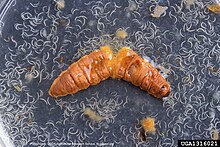Tapinarof
 | |
| Names | |
|---|---|
| Trade names | Vtama |
| Other names | Benvitimod; GSK-2894512; (E)-3,5-Dihydroxy-4-isopropyl-trans-stilbene; 3,5-Dihydroxy-4-isopropylstilbene |
| |
| Clinical data | |
| Main uses | Plaque psoriasis[1] |
| Side effects | Folliculitis, itchiness, contact dermatitis[1] |
| Routes of use | Topical |
| Legal | |
| License data | |
| Legal status | |
| Chemical and physical data | |
| Formula | C17H18O2 |
| Molar mass | 254.329 g·mol−1 |
| 3D model (JSmol) | |
| |
| |
Tapinarof, also known as benvitimod and sold under the brand name Vtama, is a medication used to treat plaque psoriasis.[1][2] It is applied to the skin.[1]
Common side effects include folliculitis, itchiness, and contact dermatitis.[1] It is an aryl hydrocarbon receptor activator.[1]
Tapinarof was approved for medical use in the United States in 2022.[1] It is not approved in either Europe or the United Kingdom as of 2022.[3] In the United States 60 grams of 1% cream costs about 1,400 USD as of 2022.[4]
Medical uses
Tapinarof is indicated for the treatment of plaque psoriasis in adults.[1]
Dosage
It is applied as a 1% cream once per day.[1]
Mechanism of action

The mode of action of tapinarof finds that it binds and activates the aryl hydrocarbon receptor , this in turn causes the downregulation of proinflammatory cytokines(interleukin 17)[6][5]
Society and culture
Names
Tapinarof is the International Nonproprietary Name (INN).[7]
Natural occurrence

It is a naturally occurring compound found in bacterial symbionts of nematodes which has antibiotic properties.[8][9]
Tapinarof, also known as benvitimod, is a bacterial stilbenoid produced in Photorhabdus bacterial symbionts of Heterorhabditis nematodes. It is a product of an alternative ketosynthase-directed stilbenoid biosynthesis pathway. It is derived from the condensation of two β-ketoacyl thioesters.[8] It is produced by the Photorhabdus luminescens bacterial symbiont species of the entomopathogenic nematode, Heterorhabditis megidis. Experiments with infected larvae of Galleria mellonella, the wax moth, support the hypothesis that the compound has antibiotic properties that help minimize competition from other microorganisms and prevents the putrefaction of the nematode-infected insect cadaver.[9]
See also
- Pinosylvin, a molecule produced in pines that does not bear the isopropyl alkylation.
References
- ↑ 1.0 1.1 1.2 1.3 1.4 1.5 1.6 1.7 1.8 1.9 "Vtama- tapinarof cream". DailyMed. 23 May 2022. Archived from the original on 3 July 2022. Retrieved 19 June 2022.
- ↑ Stein Gold, Linda; Rubenstein, David S.; Peist, Ken; Jain, Piyush; Tallman, Anna M. (September 2021). "Tapinarof cream 1% once daily and benvitimod 1% twice daily are 2 distinct topical medications". Journal of the American Academy of Dermatology. 85 (3): e201–e202. doi:10.1016/j.jaad.2021.04.103.
- ↑ "Tapinarof". SPS - Specialist Pharmacy Service. 29 August 2020. Archived from the original on 26 January 2022. Retrieved 12 December 2022.
- ↑ "Vtama Prices, Coupons, Copay & Patient Assistance". Drugs.com. Retrieved 12 December 2022.
- ↑ 5.0 5.1 Bissonnette, Robert; Stein Gold, Linda; Rubenstein, David S.; Tallman, Anna M.; Armstrong, April (1 April 2021). "Tapinarof in the treatment of psoriasis: A review of the unique mechanism of action of a novel therapeutic aryl hydrocarbon receptor–modulating agent". Journal of the American Academy of Dermatology. 84 (4): 1059–1067. doi:10.1016/j.jaad.2020.10.085. ISSN 0190-9622. Archived from the original on 18 December 2023. Retrieved 18 August 2024.
- ↑ "Vtama (tapinarof topical) dosing, indications, interactions, adverse effects, and more". reference.medscape.com. Archived from the original on 30 April 2024. Retrieved 18 August 2024.
- ↑ World Health Organization (2017). "International nonproprietary names for pharmaceutical substances (INN): recommended INN: list 78". WHO Drug Information. 31 (3). hdl:10665/330961.
- ↑ 8.0 8.1 Joyce SA, Brachmann AO, Glazer I, Lango L, Schwär G, Clarke DJ, Bode HB (2008). "Bacterial biosynthesis of a multipotent stilbene". Angewandte Chemie. 47 (10): 1942–1945. CiteSeerX 10.1.1.603.247. doi:10.1002/anie.200705148. PMID 18236486.
- ↑ 9.0 9.1 Hu K, Webster JM (August 2000). "Antibiotic production in relation to bacterial growth and nematode development in Photorhabdus--Heterorhabditis infected Galleria mellonella larvae". FEMS Microbiology Letters. 189 (2): 219–223. doi:10.1111/j.1574-6968.2000.tb09234.x. PMID 10930742.
External links
| External sites: | |
|---|---|
| Identifiers: |
|
- Pages using duplicate arguments in template calls
- Chemical articles with unknown parameter in Infobox drug
- Chemical articles without CAS registry number
- Articles without EBI source
- Chemical pages without ChemSpiderID
- Chemical pages without DrugBank identifier
- Articles without KEGG source
- Articles without UNII source
- Drugs missing an ATC code
- Articles containing unverified chemical infoboxes
- Drugs not assigned an ATC code
- Psoriasis
- Stilbenoids
- RTT
